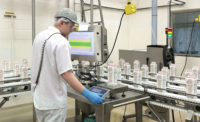SPC Software at Your Service
Though the concepts haven’t changed, SPC software continues to evolve












Evan Miller recalls an experience a few years ago during an auto industry workshop in Detroit. He was shocked at the level of knowledge from tier one, two and three suppliers (not his customers). Though it was a small group, he was left thinking that after the recession, “A lot of the knowledge of quality techniques had walked out the door,” says Miller. “They were trying to figure out how to spell SPC.”
Although he was exaggerating, Miller, president of Hertzler Systems, thought that the recession had eroded knowledge of statistical process control.
Statistical process control offers numerous benefits in tracking and improving processes and creating better products. SPC methods are not new—it’s been around since at least the 1930s—but SPC software continues to evolve. As Miller sometimes tells his customers, it’s not your father’s SPC software. Although you likely already use some form of SPC software, it may be time to consider if you are using it effectively.
TECH TIPSBefore you look at any SPC software, think about what you would like to get out of a new system. Consider what your customers want and need, and how the software will deliver this. Maintain a plan on what you and your customers are looking for. |
SPC Benefits
William A. Levinson of Levinson Productivity Systems explains that SPC software is so important because it lets you know if there are any undesirable changes in the process that you have to react to. Variations can be tracked and resolved before they become an issue.
SPC software can also aid Six Sigma projects, although of course you have to invest in it first. Jay Arthur, president and CEO of KnowWare International, says, “Far too many companies train Green Belts and Black Belts but do not buy them any SPC software at all. None. So they spend $5,000-plus on training but don’t give them the tools to do the job. Consultants sell their training courses without software to keep the cost down and expect the company to buy the software, which they don’t. This is like teaching someone to be a surgeon, but not giving them a sterile operating room and scalpels,” Arthur says. “It’s silly, but it happens a lot.”
If you’ve decided to invest in both training and software, consider that software vendors have seen countless customers go through the same steps and they know how to make it easier. During the software selection process, be sure to get management, quality, operators, and IT involved. As with any initiative, deploying new software will go much better if management supports it. The quality team obviously should be involved, as well as operators who will be using the system in order to highlight its importance. Finally, it is also important to keep IT informed so they can help execute the deployment.
Selecting Software and What Not To Do
Before you look at any software, think about where you want to be in the future. “Imagine yourself a year from now, after you’ve deployed the system,” says Steve Daum, manager of software development at PQ Systems Inc. “What will you have then that you don’t have now?” Consider what your customers want and need, and how the software will deliver this.
What Questions Should Manufacturers Ask SPC Vendors?Steve Daum, manager of software development at PQ Systems Inc., says manufacturers should ask vendors these questions: “How would you compare your learning curve to others in your arena? When people deploy your solution, what are the most common issues that come up?
Among the tech support calls that you get, how do they break down? If I have existing data, what kind of help can I expect to get with the migration?”
Paul Oxfeldt, director of corporate sales development at ASI DataMyte, suggests “Will it be flexible for me when I get new things in the future? Will it fit my workflow and my company? Ask how the vendor will support that. How can you help me save time and money? Don’t be afraid to ask the vendor to support you in the business case.” Ben Ha, product manager at Zontec, says companies should ask how long it takes to train on the vendor’s software. “If it takes a week, to me that sounds very difficult to learn,” Ha says. He also suggests asking: “How soon will we see a return on investment? Can your software create new business for me?” |
Miller suggests treating an SPC deployment like a kaizen event. “That’s really what it is. Customers are used to kaizen events; think of software deployment in the same ways. It's a critical thing, it will take effort and investment, but it will pay off, let’s plunge into it and do it.”
He suggests regular checkups on the progress of the deployment, and that companies should avoid chasing after “bright shiny objects” and maintain a plan on what they are looking for.
Companies should also avoid trying to scale up a solution too quickly. Daum says he has seen this often over the years. In week one, the company deploys a new software. By week two, they are working with 2,000 charts. By week three, they have expanded yet again. “Of those 2,000 charts, maybe only 30 of them provided value,” Daum says. “Just because you have a lot of data doesn’t mean you have to look at all of it with a control chart.”
Trying to customize a solution immediately is a related problem. Daum says some customers will get new software and then think about customizing it on the first or second day. “It’s better to use and understand the system before you invest like that,” Daum says. Just consider trying to customize Microsoft Word the first day you used it. You might not have realized that the features or shortcuts you needed were already available.
Get More Out of Your Software
Now let’s say that you have deployed SPC software. How can you try to get the most out of the software? First, make sure you are using it for improvement, not just because everyone else is doing it. SPC software done just at a customer’s request might not be software that you are using well.
And consider how the software vendor can help you. Companies offer a variety of ways to keep customers informed of software features, such as company blogs, newsletters, and software tune-ups. These can all help you get more benefit out of a system you already use.
Miller says that the tune-up training helps bring people up to date on the software and explains the system to people who might be new to the company. When companies lose key staff, they may take this SPC knowledge with them. “When that expertise walks out the door, how do you bring people up to be able to fill those shoes?” Miller asks. Training sessions are one way to combat that.
SPC Today
And even if your staff hasn’t changed, SPC software has. The software is not immune to larger technology trends. As with other technology, people want their SPC software to be available anywhere, in any device and in any facility across the globe.
“We’re so tuned to having anything we want in our pockets through our devices, people expect that full functionality in their SPC software,” says Steve Wise, vice president of statistical methods at InfinityQS. “When I started out 25 years ago, we were convincing people to put their pencils down. We’ve seen an evolution over time.”
In addition to being automated, data has also gone global. It can’t just be tucked away on a server in the plant—it has to be available everywhere, in real-time. “As an industrial statistician, I love these trends,” Wise says. “No longer are we trying to educate industry, they are coming to us, asking for more accessibility to the data.”
Along with data at your fingertips, showing the data to others is also important. Companies want visual representation of data that they can take into a conference room. The data can be presented on a flat screen during a shift change meeting, or on the plant floor to show how each line is performing. This data visualization can improve quality, and people appreciate the value it offers.
“Being able to understand the trends, see things in real time and respond to it in real time is really critical,” Miller says. “There is still a lot of opportunity for real time SPC out in the industry.”
Looking for a reprint of this article?
From high-res PDFs to custom plaques, order your copy today!












